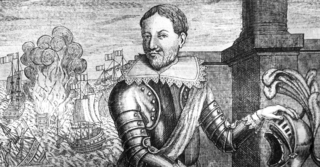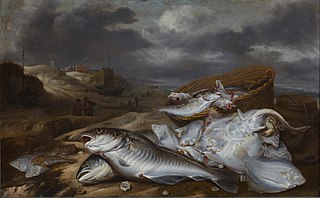Related Research Articles

Orlando di Lasso was a composer of the late Renaissance. The chief representative of the mature polyphonic style in the Franco-Flemish school, Lassus stands with William Byrd, Giovanni Pierluigi da Palestrina, and Tomás Luis de Victoria as one of the leading composers of the later Renaissance. Immensely prolific, his music varies considerably in style and genres, which gave him unprecedented popularity throughout Europe.

Hubert Waelrant or Hubertus Waelrant was a Flemish composer, singer, teacher, music editor, bookseller, printer and publisher active in 16th century Antwerp. He was a member of the generation of the Franco-Flemish School of composers who were contemporaries of Palestrina. Unlike famous composers of his time he mostly worked in northern Europe. His style is a transition between that of Nicolas Gombert and the mature Orlande de Lassus. His compositions were modern in the use of chromaticism and dissonance.

Lodewijk de Bisschop, Latinised as Ludovicus Episcopius was a Flemish Roman Catholic priest and composer of the late Renaissance and one of the first to compose secular songs in the Dutch language.

Jan van Wintelroy or Joannes Wintelroy was a Franco-Flemish composer and choirmaster.

Theodor Evertz was a Franco-Flemish composer from the Renaissance.

Jan Jacobsen was a Flemish naval commander and Dunkirker during the Eighty Years' War. He became a posthumous hero when, after battling an enemy fleet for over 13 hours, he destroyed his own ship rather than surrender.
Jan Rijspoort was a Flemish composer who was active at the end of Renaissance and beginning of the early Baroque period. He worked in the Spanish Netherlands at the end of the 16th century and the beginning of the 17th century. Very little is known about his life.

Camerata Trajectina is a Dutch early music ensemble.
Jacobus Ruurd "Jaap" Bruijn, was a Dutch maritime historian. He was professor of maritime history at the University of Leiden from 1979 until his retirement in 2003. During his 41-year teaching career as The Netherlands' only university professor of maritime history, he guided the doctoral theses of at least 49 graduate students.

Petit Jean De Latre or Joannes de Latre was a Flemish Renaissance composer and choirmaster who worked in Liège and Utrecht. He is no longer believed to be same person as Claude Petit Jehan who died in 1589.
Filips van Zuylen was a Dutch corsair active in the 1620s. As part of the Groot Desseyn plan, he was particularly active against the Portuguese in West Africa but failed to capture the colony of Luanda, an important center for the Atlantic slave trade, in early 1624. After this initial defeat he decided to wait for reinforcements from Brazil before making a second attempt, this time with fellow corsair Piet Heyn, in October of that same year. While approaching from the south Heyn missed van Zuylen's 3-ship squadron, waiting to the north of Loanda, and decided to go ahead with the attack on his own. Heyn's fleet suffered a disastrous defeat as a result. Many of his ships became stuck in the shallows just outside Loanda and, when other ships stopped to free them, made easy targets for the Portuguese cannons. Heyn quickly realized that his seven ships could not breach the colony's heavily defended fortifications. Following a failed nighttime sortie against Portuguese merchant ships moored in the harbor, he ordered a withdrawal and the Dutch corsair fleet retreated back to friendly ports. In 1641, another Dutch corsair, named Cornelis Jol, succeeded in capturing Luanda after a brutal battle. Nevertheless, the colony did not last long under Dutch rule, as it was recaptured by the Portuguese in 1643.

Joannes Zacheus was a composer of the Franco-Flemish School.

Jan Belle was a Flemish composer from the Franco-Flemish School and a music theorist.

Jacob Vredeman de Vries was a kapellmeister and composer of music in Leeuwarden. Jacques Vredeman published 12 villanelles in the West Frisian language.

Jacob Bathen or Jacob Baethen, Latinised as Jacobus Bathius, Iacobus Batius and Jacobus Bathenius, was a Flemish bookseller, printer and publisher of the 16th century, mainly known now for music publications. He is sometimes confused with Johannes Baethen, a printer active in Leuven and Cologne between 1552 and 1562, who was likely his brother. Jacob was active in Leuven, Maastricht and Düsseldorf. He is mainly remembered for his publication of the so-called Maastricht songbook of 1554, which is one of only five surviving song books in the Dutch language from the 16th century.
Hendrik Frans Karel van Nierop is a historian of early-modern Holland and professor emeritus of the University of Amsterdam.

Willem van Haecht, sometimes also Willem van Haecht the elder to distinguish him from the painter Willem van Haecht was a Flemish poet writing in the Dutch language. He was also a cloth merchant, draughtsman, a bookseller and publisher. He was a member since 1552 and from 1558 a factor of the chamber of rhetoric De Violieren in Antwerp. In that role he played an important part in the transition of the development of theatre in Flanders from plays mainly dealing with epic, moralising or allegorising themes towards plays expressing the humanist ideas of the Renaissance. He published the Psalms of the Bible in Dutch verse and also wrote poems and songs.

Pieter van Schaeyenborgh was a Flemish painter, who worked in the Dutch Republic in the latter part of his career. He is known for his still lifes of fish.

Wein van Cotthem was a Brussels clerk, chaplain and chronicler.
References
- ↑ Jan Willem Bonda, De meerstemmige Nederlandse liederen van de vijftiende en zestiende eeuw. Hilversum, Verloren, 1996. ISBN 90-6550-545-8, pp.89-90, 596-598
- ↑ Jan Willem Bonda, De meerstemmige Nederlandse liederen van de vijftiende en zestiende eeuw. Hilversum, Verloren, 1996. ISBN 90-6550-545-8, p.70
- ↑ Jan Willem Bonda, De meerstemmige Nederlandse liederen van de vijftiende en zestiende eeuw. Hilversum, Verloren, 1996. ISBN 90-6550-545-8, p. 47
- ↑ Jan Willem Bonda, De meerstemmige Nederlandse liederen van de vijftiende en zestiende eeuw. Hilversum, Verloren, 1996. ISBN 90-6550-545-8, p.89
- ↑ Translation from the first stanza by Stratton Bull in the booklet of the cd Jacob Obrecht, Chansons, Songs, Motets, by Capilla Flamenca and Piffaro, Davidsfonds/Eufoda, 2005
- ↑ Florimond van Duyse, Het oude Nederlandsche lied. Tweede deel. Martinus Nijhoff / De Nederlandsche Boekhandel, The Hague/Antwerp, 1905. pp.1050-1054